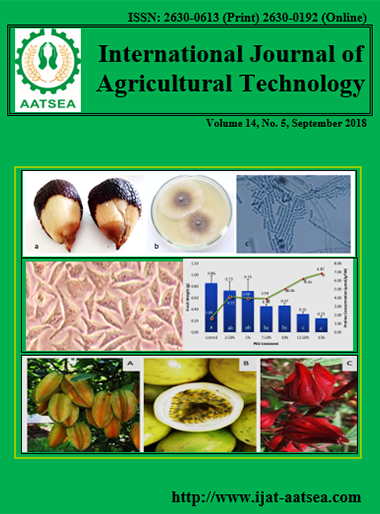Thielaviopsis spp. from Salak [Salacca zalacca (Gaerntn.)Voss] in Indonesia
Main Article Content
Abstract
Thielaviopsis sp. Anamorph Ceratocystis sp. is an important agricultural pathogen fungal genus. Cultural characteristics showed two different groups recorded as brown and black colonies on the surface of the artificial media. Conidial structures showed morphology typical of Thielaviopsis. DNA sequences were generated for Internal Transcribed Spacer regions (ITS1 and ITS2). Morphology and molecular analyses showed the causal agents of rotten Salak were Thielaviopsis paradoxa and T. ethacetica. The descriptions of the fungi were illustrated in this study.
Article Details

This work is licensed under a Creative Commons Attribution-NonCommercial-NoDerivatives 4.0 International License.
References
Ahmad, R. Z., Setiabudhi, D. A. and Wulandari, N. F (2017). The mold causing agent of rotten snake fruit (Salacca zalacca (Gaerntn.)Voss) from three traditional fruit markets. Proceeding Second EcoBiology. International Conference on Bioscience. IPB Convention Center, Bogor, West Java, Indonesia.
Alvarez, E., Llano, G. A., Loke, J. B. and Chacon, M.I. (2012). Characterization of Thielaviopsis paradoxa isolates from oil palms in Colombia, Ecuador and Brazil. Journal of Phytopathology 160:690-700. doi:10.1111/jph.12012
Amy, E., Paulin–Mahady, TC Harrington Doug McNew (2002). Phylogenetic and taxonomic evaluation of Chalara, Chalaropsis, and Thielaviopsisanamorphs associated with Ceratocytosis. Mycologia 94: 62-72.
Beer, Z. W., de Duong, T. A., Barnes, I., Wingfield, B. D. and Wingfield, M. J. (2014). Redefining Ceratocystis and allied genera. Study of Mycology. 79:187-219.
Dos-Santos, A. F., Inacio. C. A., Guedes, M. V. and Tomaz, R. (2012). First report of Thielaviopsisparadoxa causing stem rot in Dracaena marginata in Brazil. Summa Phytopathol 38:345-354.
Elliott, M. L. (2018). Thielaviopsis trunk rot of palm. UF/IFAS Extentions US Department of Agriculture, University of Florida, IFAS Florida, U.S.A.
Hiraishi, A., Kamagata, Y. and Nakamura, N. (1995). Polymerase chain reaction amplification and restriction fragment length polymorphism analysis of 16S rRNA genes from methanogens. J BiosciBioeng 79:523-529.
Kile, G. A. (1993). Plant Diseases caused by species of Ceratocystis sensu strict and Chalara. In: Wingfield M. J., Seifert K. A. and Webber, J. F. (eds) Ceratocystis and Ophiostoma Taxonomy, Ecology and Pathogenicity. The American Phytopathological Society. St. Paul, Minnesota, APS Press.
Liptan (2000). Identifikasi Hama PenyakitSalak (Salaccaedulis). Rein. IP2TP Yogyakarta.
Mbenoun, M., de Beer, Z., Wilhelm., Wingfield, M. J, Wingfield, B. D. and Roux, J. (2014). Reconsidering species boundaries in the Ceratocystisparadoxa complex, including a new species from oil palm and cacao in Cameroon. Mycologia. 106:757-784.
Santosa, Chatib, O. C., Fahmy, K. and Artika, F. (2017). Investigation the effect of chitosan coating and temperature storage to extend the shelf life Zalacca (SalaccaZalacca). IntAdvSciEngInf Tech 394-402.
Sari, S. L. A., Setyaningsih, R. and Wibowo, N. F. A. (2017). Isolation and screening of cellulolytic fungi from Salacca zalacca leaf litter. Biodiversitas 18:1282-1288.
Soytong, K., Pongnak, W. and Kasiolarn, H. (2015). Biological Control of Thielaviopsis Bud Rot of Hyophorbe lagenicaulis in the field. Journal of Agricultural Technology 1:235-245.
Went, F. A. F. C. (1893). De ananasziekte van het suikerriet. Mededeelingen Proefstation West–Java 5:1–8.
White, T. J., Bruns, T., Lee, S. and Taylor, J. (1990). Amplification and direct sequencing of fungal ribosomal RNA genes for phylogenetics. In: Innis M. A., Gelfand D. H., Sninsky J. J. and White T. J. (editors). PCR protocols: a guide to methods and applications. New York: Academic Press, pp. 315-322.
Wijesinghe, C. H., Wijeratnam, R. S., Samarasekara, J. K. R. R. and Wijesundera, R. L. C. (2010). Biological control of Thielaviopsis paradoxa on pineapple by an isolate of Trichoderma asperellum. Biological Control 53:285-290.
Wulandari, N. F., To–anun, C., Hyde, K. D., Duong, L. M., de Gruyter, J., Meffert, J. P., Groenewald, J. Z. and Crous, P. W. (2009). Phyllosticta citriasiana sp.nov., the cause of Citrus tan spot of Citrus maxima in Asia. Fungal Diversity 34:23-39.


